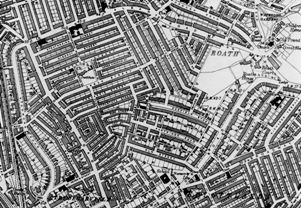THE HISTORY OF CARDIFF'S SUBURBS
PLASNEWYDD
Incorporating part of Roath
CONTENTS
Tap or click to open / closeAn Ancient Outpost
There is evidence that a settlement or outpost has been in Plasnewydd for over 1,000 years. A circular mound surrounded by a ditch, suggests that Plasnewydd may have been an administrative centre for the early Welsh rulers of Cibwr (Kibbor).
During the time of the Norman Conquest in the late 11th Century, a small village called Roath Dogfield was founded in what is now the electoral division of Plasnewydd.
Robert Fitzhamon took these lands for his own, and built The Court, which would become Roath Manor. This establishment would focus on dairy farming, to help sustain Fitzhamon's extensive workforce at Cardiff Castle.
Although the present building dates back to 18th Century, a survey by Rice Merrick (Rhys Meurug) in 1578 mentions the ruins of a manor house.
The Williams Family
Source: OS
By the early 14th Century a mill had been built for near The Court for the Lord of Glamorgan, and was powered by the stream which still flows through Waterloo Gardens today.
The mill was rebuilt in the 18th Century and remained in use until it was demolished to make way for new houses, in 1897. The Williams family became the owners of Roath Court in 1824.
The most noteworthy member of the family was Charles Croft Williams (died 1860) who was an alderman and several times the Mayor of Cardiff.
In 1952 the property became a funeral home, and still stands today as a Grade II listed building.
Tredegarville and 'The New Place'
Lord Tredegar was another prominent landowner in Plasnewydd, and from the middle of the 19th Century fine houses were built on his land.
The district around The Parade, The Walk, East Grove and West Grove became known as Tredegarville.
Two houses on The Walk were built by James Howell, the Cardiff store owner. Each of these houses were used by the Lord Mayors of Cardiff, until they were sold off and redeveloped.
Plasnewydd takes it's name from 'The New Place' built in late 17th Century. It was the home of Edwards Richard, whose daughter Arabella married into the wealthy Scottish Mackintosh family.
Plasnewydd was renovated, and battlements were added to the roof, giving it the nickname of 'Roath Castle'. In 1890, Plasnewydd was given to the tenants of the village, and subsequently acquired by the Town Council.
Cardiff's first infirmary, the Glamorgan and Monmouthshire, opened in 1837 just off Newport Road, funded by generous donations from notable businessmen, and money raised at the Eisteddfod in 1834.
The Infirmary was extended in 1866, and soon after a new infirmary at Longcross was opened. The former hospital then became the first campus of the new University of Wales College at Cardiff, until 1909; when the university moved to Cathays Park. The building was demolished in 1966.
Plasnewydd's Development
The houses in Ninian Road were built on land owned by the Bute Family, and the road is named after Lord Ninian Stuart, MP for Cardiff.
Castle Road became City Road in 1905 to reflect Cardiff's new City status, although the history doesn't end there.
The very top of City Road used to lead to a Gallows Field (Plwcca Halog). Albany Road (originally Merthyr Road before 1884) soon became the district shopping centre.
Roath was absorbed into Cardiff's boundaries as early as 1875, and as such, Plasnewydd became part of Cardiff at the same time.
As in Roath and Penylan, extensive housing construction took place during the 20th Century, although in Plasnewydd, due to lack of space, the properties are not particularly grand or spacious.
Roath Castle is now the Mackintosh Institute, and surrounded by its original extensive grounds, it now operates as a community centre complete with Tennis courts.
Albany, Wellfield and City Road are all major hubs of activity, with all manner of tastes catered for in the district's unique shops.
Risking Loss of Identity and Rural Feel
In 2008, Cardiff Council thought that the name Plasnewydd was not one with which local residents of the community particularly identifed with - and proposed to change it.[PDF]
Objections were raised by local residents regarding the legitimacy of the proosal, and concerns about future potential confusion with historical records. Ultimately, the change did not take place. The issue was raised again in 2020 - this time by the Liberal Democrat party, who launched a petition calling on the Plasnewydd electoral ward to be renamed. Thankfully - the petition clearly failed - and Plasnewydd retains its identify.[REF]
The rural feel of Waterloo Gardens and Roath Brook were changed forever as a result of the flood prevention works, which took place between 2018-20. Many trees were felled and biodiverse areas of land were destroyed to make way for large concrete walls running the length of the brook. New pavements and bridges to 'counter' the risk of flooding to nearby properties were all built on land that could have previously soaked up the excess water during the increasingly wet winters in Wales. A cheaper, more attractive option would have been to widen and deepen the brook, and create a more natural meandering route.
PAGE UPDATE HISTORY
10 April 2024 (Content and coding updates)
01 December 2014 (Coding updates)
July 2009 (Page Created)

